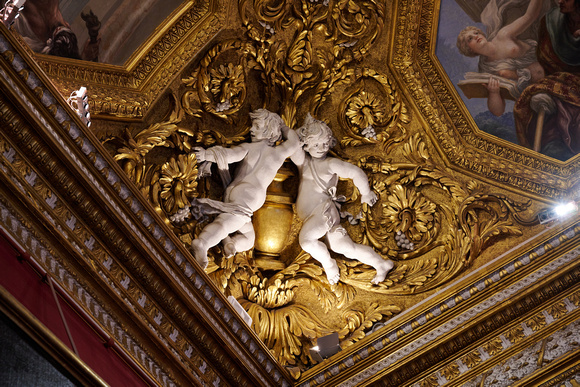The Palatine Gallery, the main gallery of Palazzo Pitti, contains a large ensemble of
over 500 principally Renaissance paintings, which were once part of the Medicis' and their successors' private art collection. The gallery, which overflows into the royal apartments, contains works by
Raphael,
Titian,
Perugino (
Lamentation over the Dead Christ),
Correggio,
Peter Paul Rubens, and
Pietro da Cortona.
[16] The character of the gallery is still that of a private collection, and the works of art are displayed and hung much as they would have been in the grand rooms for which they were intended rather than following a chronological sequence, or arranged according to school of art.
The finest rooms were decorated by Pietro da Cortona in the high
baroque style. Initially Cortona frescoed a small room on the
piano nobile called the Sala della Stufa with a series depicting the Four Ages of Man which were very well received; the
Age of Gold and
Age of Silverwere painted in 1637, followed in 1641 by the
Age of Bronze and
Age of Iron. They are regarded among his masterpieces. The artist was subsequently asked to fresco the grand ducal reception rooms; a suite of five rooms at the front of the palazzo. In these five Planetary Rooms, the hierarchical sequence of the deities is based on Ptolomeic cosmology; Venus, Apollo, Mars, Jupiter (the Medici Throne room) and Saturn, but minus Mercury and the Moon which should have come before Venus. These highly ornate ceilings with frescoes and elaborate stucco work essentially celebrate the Medici lineage and the bestowal of virtuous leadership.
[17] Cortona left Florence in 1647, and his pupil and collaborator,
Ciro Ferri, completed the cycle by the 1660s. They were to inspire the later Planet Rooms at
Louis XIV's
Versailles, designed by
Le Brun.
The collection was first opened to the public in the late 18th century, albeit rather reluctantly, by Grand Duke
Leopold, Tuscany's first enlightened ruler, keen to obtain popularity after the demise of the Medici.


